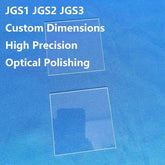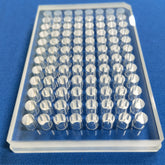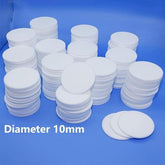The drilling accuracy control of sapphire lenses
Sapphire lenses are a critical component of optical elements, and the accuracy of their processing directly impacts the performance of optical instruments. The drilling process, a pivotal step in the manufacturing of sapphire lenses, demands even greater precision and control. The size error of micro-holes frequently needs to be controlled to within the micrometer level, which poses significant demands on the processing technology.
Sapphire, a high-hardness material, is primarily drilled using laser processing technology to achieve precise results. Laser drilling technology is characterized by its non-contact mode of operation, its ability to generate a small heat-affected zone, and its high level of precision. These properties make it particularly well-suited for the processing of hard and brittle materials such as sapphire. In actual production, ultraviolet lasers and picosecond lasers are two commonly used processing light sources. Due to their wavelength, ultraviolet lasers are capable of achieving a smaller focused spot, making them well-suited for processing micro-holes with diameters of less than 100 micrometers. Picosecond lasers, with their ultra-short pulse characteristics, can effectively reduce the heat-affected zone and improve the quality of the hole wall.

The process of ensuring punching accuracy involves the systematic optimization of multiple key parameters. Firstly, the selection of laser power is paramount. Excessive power can lead to material vaporization, potentially resulting in uneven openings. However, if the power is insufficient, it may not be able to effectively penetrate the material. Secondly, the setting of the pulse frequency is crucial. If the frequency is excessively high, this may result in heat accumulation and potentially induce cracking. If the frequency is excessively low, it will have a detrimental effect on processing efficiency. Furthermore, the quality of the punching process depends to a large extent on the parameters such as the focusing position, the pressure of the auxiliary gas and the scanning speed. In actual production, it is usually necessary to determine the parameter combination through a large number of process tests based on the specific sapphire material and hole type requirements.
During the drilling process, the implementation of real-time monitoring systems has enhanced the reliability of precision control. The high-precision CCD vision system can capture the processing status in real time, and in combination with the closed-loop control system, adjust the processing parameters promptly. This real-time feedback mechanism can effectively compensate for the accuracy deviation caused by material inhomogeneity or equipment fluctuations.

The quality inspection following drilling is also an essential component of precision control. Modern inspection technology utilizes equipment such as white light interferometers or laser confocal microscopes, which can obtain three-dimensional parameters like the depth, taper and roundness of the hole, providing data support for precision control. Especially for the strictly required irregular holes or array hole structures, the automated optical inspection system can achieve rapid full inspection to ensure that each hole meets the design requirements.
It is imperative to consider the impact of environmental factors on drilling accuracy. Temperature fluctuations can lead to variations in the focal length of the optical system, while humidity changes may impact the efficiency of laser transmission. Therefore, high-precision processing usually needs to be carried out in a clean environment with constant temperature and humidity. At the same time, it is also important to note that the vibration isolation treatment of the equipment is equally crucial. Even the slightest vibration has the potential to cause the laser focus to shift, thereby affecting the drilling accuracy. Some processing equipment is equipped with an active vibration isolation system, which is able to effectively isolate the influence of ground vibration on the processing process.
The precision control of sapphire lens drilling is a complex systems engineering task that integrates multiple disciplines, including optics, materials science, mechanics, and control theory. Achieving stable and efficient precision machining requires a comprehensive consideration of various factors such as equipment performance, process parameters, environmental conditions, and material characteristics. Advances in this field not only demonstrate the current limits of modern manufacturing precision but also reflect humans’ ongoing pursuit of excellence in craftsmanship.






